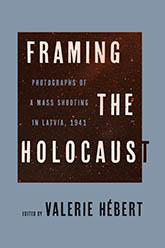|
Framing the Holocaust
Photographs of a Mass Shooting in Latvia, 1941
Edited by Valerie Hébert
“Demonstrates that historical research into photography could benefit tremendously from collaboration with film and cultural studies. An analysis of the assumptions that guided these photographers exposes the intended effect of the images.”
—H-Soz-Kult
When viewing atrocity photographs, do we revive the original violence
In December 1941, German police and their local collaborators shot 2,749 Jews at the beach in Šķēde, near Liepāja, Latvia. Twelve photographs were taken at the scene. These now-infamous images show people in extreme distress, sometimes without clothing. Some capture the very moments when women and children confronted their imminent deaths, while others show their dead bodies. They are nearly unbearable to look at—so why should we? Framing the Holocaust offers a multidimensional response to this question.
While photographs are central to our memory of modern historical events, they often inhabit an ambivalent intellectual space. What separates the sincere desire to understand from voyeuristic curiosity? Comprehending atrocity photographs requires viewers to place themselves in the very positions of the perpetrators who took the images. When we engage with these photographs, do we risk replicating the original violence? In this tightly organized book, scholars of history, photography, language, gender, photojournalism, and pedagogy examine the images of the Šķēde atrocity along with other difficult images, giving historical, political, and ethical depth to the acts of looking and interpreting.
With a foreword by Edward Anders, who narrowly escaped the December 1941 shooting, Framing the Holocaust represents an original approach to an iconic series of Holocaust photographs. This book will contribute to compelling debates in the emerging field of visual history, including the challenges and responsibilities of using photographs to teach about atrocity.
Valerie Hébert, professor of history and interdisciplinary studies at Lakehead University Orillia, is the author of Hitler’s Generals on Trial: The Last War Crimes Tribunal at Nuremberg.
Praise
“Offers a holistic consideration of the chilling images.”
—The Times of Israel
“An original and highly valuable contribution to the debate about how to work with the photographic evidence of the Holocaust, and by extension, the broader visual representation of genocide, trauma, and crimes against humanity.”
—Paul Lowe, coauthor of Understanding Photojournalism
“An excellent and necessary collection on a timely subject. Framing the Holocaust, as the title suggests, addresses both the act of photographing atrocity and the interpretive and explanatory work vital to viewing and understanding such images. Well written, clearly argued, and engaged with current research, the essays form a rich assemblage of insights that unfold in a logical progression while avoiding simplistic and one-dimensional judgments.”
—Kobi Kabalek, author of Rescue and Remembrance: Imagining the German Collective after Nazism
Table of Contents
List of Illustrations
Acknowledgments
Foreword by Edward Anders
Introduction: Twelve Photographs
Valerie Hébert
Not to Tiptoe Away in the Face of Suffering: Why We Look at Holocaust Photographs
Valerie Hébert
Investigating Both Sides of the Camera on the Beach at Šķēde
Daniel Newman
Reading against the Gaze: Perpetrator Motives and Subject Responses in Photographs of a Mass Shooting
Tanja Kinzel
Ordinary Acts, Extraordinary Crimes: Photographic Practice and Atrocity
Daniel Hoffman
Describing Atrocity: Soviet Words on German Perpetrator Images
Marilyn Campeau
A Day at the Beach: The Šķēde Massacre and Littoral Photography
Daniel H. Magilow
Representations of Female Bodies in Holocaust Photographs
Dorota Glowacka
A Pedagogy of Witnessing: Reading and Interpreting the Šķēde Photographs in the Classroom
Hilary Earl
Contributors
Index
|

Larger images
New in Paperback!
December 2024
LC: 2022058115 DS
296 pp. 6 x 9
41 b/w photos
|

